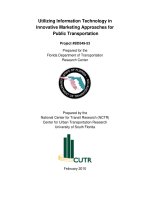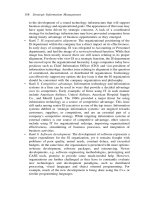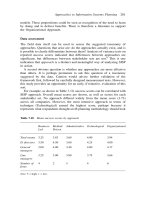MANAGING MARKETING INFORMATION
Bạn đang xem bản rút gọn của tài liệu. Xem và tải ngay bản đầy đủ của tài liệu tại đây (2 MB, 51 trang )
5-1. MANAGING MARKETING INFORMATION
Marketing Research —
The systematic design, collection, analysis,
and reporting of data relevant to marketing
information to help reduce uncertainty when
making marketing decisions.
COLLEGE OF BUSINESS ADMINISTRATION
CHUNG-ANG UNIVERSITY
PROF HYUNSUK SUH
2
The objectives of the current chapter are listed below.
Objectives
Understand the definition of a marketing information system
Understand the basics of marketing research
Understand the various methods of collecting and analyzing research
information
0. Objectives
3
What is “Marketing Information and Research”?
Marketing Information and Research
Marketing Information Systems
Marketing Information Systems: People, equipment, and procedures to
gather, sort, analyze, evaluate, and distribute needed, timely, and accurate
information to marketing decision makers.
Marketing Research
Marketing Research: The systematic design, collection, analysis, and
reporting of data relevant to a specific marketing situation facing an
organization
Kotler and Armstrong, 2012, 2014
1. Marketing Information System
4
The examples of the sources of primary and secondary data are illustrated in the
following diagram.
Primary and Secondary Data Sources
1. Marketing Information System
5
What is “Marketing Research ”?
Marketing Research
2. Marketing Research
The systematic and objective process of generating information to aid in
making marketing decisions.
Zikmund, 2003
It is the process of designing, gathering, analyzing, and reporting information
that may be used to solve a specific marketing problem.
Burns and Bush, 2003, 2007
The systematic and objective identification, collection, analysis,
dissemination, and use of information for the purpose of assisting
management in decision making related to the identification and solution of
problems in marketing.
Malhotra, 2004, 2007, 2009, 2011, 2013
6
What is “Marketing Research ”?
Marketing Research Definitions
Marketing research is a function that links the customer to the marketer
through information - information used to identify and define marketing
opportunities and problems; generate, refine, and evaluate marketing actions,
monitor marketing performance, and improve understanding of marketing
as a process
Churchill and Brown, 2007, 2010
2. Marketing Research
7
The Theory and Data Relationship
THEORY
DATA
Inductive
Reasoning
Deductive
Reasoning
Ideas: What we think
Reality: What we observe
Empirical
Generalization
Hypothesis
The deductive and inductive reasoning logically connect theory and the data, the
evidences found in material world.
2. Marketing Research
8
Three different types of research design are described below.
Research design in which the major emphasis is on gaining ideas and insights; it is
particularly helpful in breaking broad, vague problem statements into smaller, more
precise sub-problem statements.
EXPLORTORY
RESEARCH
A type of conclusive research that has as its major objective the description of
something; It is either the frequency of occurring something or relationship between
variables – usually market characteristics or functions.
DESCRIPTIVE
RESEARCH
A type of conclusive research where the major objective or emphasis is on
determining cause-and-effect (causal) relationship one variable has an impact upon
another. The terms “independent” and “dependent” variables are often employed
in this context.
CAUSAL
RESEARCH
Types of Research Design - Definition
2. Marketing Research
9
The characteristics and examples of different marketing research designs are shown
below.
Types of Research Design – Characteristics and Examples
2. Marketing Research
Exploratory Research
Descriptive Research
Causal Research
Characteristics
Classification of the nature of
ambiguous problem to gain
better understanding
Not intended to provide
conclusive evidence to
determine particular action
Description of characteristics
of a population or phenomenon
It seeks to determine the
answers to WHO, WHAT, WHEN,
WHERE, and HOW questions
Based on previous
understanding of the nature of
the problem
Identify cause-and-effect
relationships among variables
The management change one
variable and then observe the
effect on another variable
Ambiguous Problem
Aware of Problem
Problem Defined
Our sales are declining and we
do not know why?
Would people be interested in
our new-product idea?
What kind of people are buying
our product? Who buys our
competitors’ product?
What features do buyers prefer
in our product?
Will buyers purchase more of
our product in a new package?
Which of the two advertising
campaigns is more effective?
Examples
10
-Becomes familiar with the basic facts,
people, and concerns
-Generate many ideas and develop
tentative theories and conjectures
-Determine the feasibility of doing
additional research
-Formulate questions and refine
issues for more systematic inquiry
Review of the concepts.
Exploratory vs. Descriptive vs. Causal Research
Concept
Review
-Provide an accurate profile of a group
-Describe a process, mechanism, or
relationship
-Find information to stimulate new
explanations
-Create a set of categories or classify
types
-Provide a verbal or numerical picture
-Determine the accuracy of a principles or theory
-Find out which competing explanation is better
-Link different issues or topics under a common general
statement
-Build and elaborate a theory so it becomes more complete
-Provide evidence to support or refute an explanation or
prediction
-Extend a theory or principles into new areas or issues
2. Marketing Research
11
The Causal Relationship
Smoking
Disease
cause
cause
effect
effect
Independent
Independent
Dependent
Dependent
What’s the meaning of this?
To say something causes something else is NOT
to suggest the dependent variable (the effect) is
totally influenced by the independent variable
Cause:
It means the variation in the dependent variable is
affected by variation in the independent variable
The primary objective of quantitative research put heavy focus on the demonstration
of “causality’ between the two variables.
Pitfalls
1. Mutual Relationship
Job Satisfaction
Productivity
Job Satisfaction
Productivity
Length of Service
2. Spurious Relationship
3. Intermediate Relationship
Job Sat
Productivity
Job
Interest
2. Marketing Research
12
The methods for collecting marketing research data are illustrated below.
Observation Questionnaire and Survey
Interview Focus group
1
2
3
4
5
Experiment
Experiment
Research Methods
3. Data Collection Methods
13
The observation is being defined by the following marketing research gurus.
The systematic activities of witnessing and recording the behavioral patterns of
objects, people, and events without directly communicating with them
Hair, 2006, 2010
The nonverbal observation is the most prevalent activity which includes
recording physical actions or movements of participants
Cooper, 2006
“We noticed people scraping the toppings off our pizza crusts. We thought at
first there was something wrong, but they said, ‘We love it, we just don’t eat the
crust anymore.’”
Tom Santor, Donatos Pizza
Definition: Observation
3. Data Collection Methods-Observation
14
Observation is defined below.
Observation
The systematic process of recording the behavioral patterns of people, objects,
and occurrences without questioning or communicating with them
OBSERVATION
3. Data Collection Methods-Observation
The problem has been defined precisely enough so that the behaviors that will be
observed can be specified beforehand and so as to the methods they use.
Structured
The problem has not been specifically defined, so a great deal of flexibility is allowed
the observers in terms of what they note and record.
Unstructured
Structured vs. Unstructured Observation
Researchers must precisely
decide which behaviors are to
be observed and which specific
categories and units will be
used to record the observation
15
The distinction between ‘Structured’ and ‘Unstructured” observation is well described
in the following examples.
Example: Structured vs. Unstructured Observation
Type A
The purchaser first paused in front of the Namyang milk. He glanced at the price on the shelf,
picked up the milk, glanced at its design and list of ingredients, and set it back down. He then
checked the label and price of Maeil milk. He set that back down and after a slight pause,
picked up a different flavor milk of Namyang, a chocolate milk. He placed it in his cart, and
moved down the aisle.
Type B
Record # 89
male female
First milk picked up for examination
__ 강성원 우유 __ 남양우유 __ 건국우유 __ 매일우유 __ 기타
Total # of milk packs picked up for examination, any brand 3
Brand Selected
__ 강성원 우유 __ 남양우유 __ 건국우유 __ 매일우유 __ 기타
Time (in front of milf shelf) 5 minutes
Example
3. Data Collection Methods-Observation
16
Think about the following issues.
Discussion Questions: Observation
1. Suppose you were asked to design appropriate communication method to find out students’
feeling and opinions about the various food services available on Chung Ang University
campus. What degree of ‘structure’ would be appropriate? What degree of ‘disguise’ would be
appropriate? What method of administration would be appropriate? Justify your answer in
terms of thinking about your decision criteria (meaning, what are some of the important
factors/criteria you must consider before you choose your method of administration?)
2. Arum is the general manager of Heuk-Suk dong Steak House. It had been open for about a
year. The steak house has been a success so far, but Arum doesn’t yet have a grasp of exactly
who her customers are. The lunch customers seem to be quite different from that of the
evening meal. She needs your help in designing a project to develop a better understanding of
her customers.
What degree of ‘structure’ would be appropriate? What degree of ‘disguise’ would be
appropriate? What method of administration would be appropriate? Justify your answer in
terms of thinking about your decision criteria.
Review of the Concepts
3. Data Collection Methods-Observation
17
Focus group interview is conducted by a trained moderator among a small group of
respondents in an unstructured and natural manner.
Focus Group
Purpose To gain insights from listening to a group of people from the
appropriate target market
Group Size 8-12
Group Composition Homogeneous, respondents, prescreened
Physical Setting Relaxed, informal atmosphere
Time Duration 1.5-2 hours
Recording Sessions recorded and transcibed
Moderator Observational, interpersonal, and communication skills
3. Data Collection Methods-Focus Group
An interview conducted among a small number of individuals simultaneously;
the interview relies more on group discussion than on directed questions to
generate data.
FOCUS GROUP
18
Let’s take a look at the following problem
Case Example of the Focus Group
In Class Exercise
Cynthia Armstrong is the owner of the clothing store that caters to college students.
Thorough informal conversations with her customers, she has began to suspect that a
video-rental store specifically targeting college students would do quite well in the local
market. While her conversations with students have revealed an overall sense of
dissatisfaction with existing rental outlets, she hasn’t been able to isolate specific areas
of concern. Thinking back to a marketing research course she took in school,
Armstrong decided that focus group research would be an appropriate method to gather
information that might be useful in deciding whether to pursue further development of
her idea to open a video rental store.
Questions:
1. What is the decision problem and relevant research problems in this situation?
2. Whom should Armstrong select as participants for the focus group? Exactly what
criteria would you establish for recruiting participants?
3. Where should the focus group session be conducted?
4. What would you need the moderator of the focus group to know before the session?
5. Develop moderator’s guidebook for the focus group.
3. Data Collection Methods-Focus Group
19
The essential point of interviewing is to “probe.” Let’s find out what probing is.
1. How do you mean that?
2. Tell me more about that
3. Anything else?
1. The response can fail to answer the question; it may be
the answers for some other question. In such a case,
the interviewer should repeat the same question.
2. The answer contains unclear concepts or terms that make
its meaning ambiguous. The interviewer should probe
saying, “How do you mean that?”
3. The answer is not detailed or specific enough.
The interviewer should probe saying, “Could you tell me
more about that?”
4. A perfectly appropriate answer has been given, but there
is a possibility that there are additional points that the
respondent could make in answers to the question.
The interviewer should ask, “Is there any thing else?”
Interview
Interviews with people knowledgeable about the general subject being investigated.
INTERVIEW
3. Data Collection Methods-Interview
Probing
20
Below are some examples which these probes would be used.
Probing “Open-Ended” Questions
Q: From your point of view, what are the best things about living in this neighborhood?
Comment1:
A1: In the last neighborhood in which we lived, it was very transient. People didn’t care about
keeping up the neighborhood.
Comment2:
Probe: Repeat the question.
A2: The people.
Comment3:
Probe: Tell me more about that.
A3: The people are good neighbors.
Comment4:
Probe: How do you mean a good neighbor?
A4: They keep to themselves. They leave you alone. You don’t have to worry about being
sociable and you don’t have to worry about what they think.
Comment5:
Probe: Okay, I have that down. Anything else about your neighbor?
Exampl
e
3. Data Collection Methods-Depth Interview
21
When a questions calls for a respondent to choose an answer from a list, and the
respondent has not done so, the marketing interviewer’s job is let respondent to
choose the answer from the list.
Probing “Closed” Questions
Interviewer: How would you rate this product – Very Good. Good, Fair, or Poor?
Respondent: From my experience, this product is not Very Good.
1. Some interviewer may check the “FAIR” box, while others would check the “POOR” box. If
the interviewer takes respondent’s words and do something to produce an answer, the
potentials for inconsistency across the interviewer is great.
2. If the interviewer probed something like: “Well, would you say fair or poor?” This also is a bad
practice that will affect the answers.
Why?
Exampl
e
3. Data Collection Methods-Depth Interview
22
Probing “Numerical” Answers
Q: In the last seven nights, how many times have you gotten fewer than eight(8) hours of
sleep?
A: I usually get eight(8) hours of sleep.
Directive Probe 1: Well, for the last seven nights, would the answer be 0?
Directive Probe 2: Well, for the last seven nights, would the best answer be 0, 1, or 2?
Nondirective Probe 1: In the last seven nights, how many times have you gotten fewer than
eight
hours of sleep?
Nondirective Probe 2: Well, for the last week, would the best answer be more than 2 times, or 2,
or fewer times?
?
What would you choose and why?
The precision is the most common problem faced by the interviewer, when an answer
calls for a numerical response.
Exampl
e
3. Data Collection Methods-Depth Interview
23
Surveys produce appropriate information about marketing world by reflecting self-
reported beliefs, opinions, characteristics, or past and present behaviors of the people.
Survey
A method of primary data collection in which information is gathered by
communicating with a representative sample of people
SURVEY
Survey samples many respondents who answer the same questions. They
measure many variables such as behavior, intentions, attitudes, awareness,
motivations, and demographic and lifestyle characteristics.
Survey methods involve a structured questionnaire give to respondents and
design to elicit specific information.
Survey research is often called correlational research. The survey researchers
use correlations in statistical analysis
Characteristics of Survey
3. Data Collection Methods-Survey
24
How long should a questionnaire be or an interview last?
The Length of Survey
Researchers prefer long questionnaire or interviews due to their cost-
effectiveness. However there is no absolute proper length. The length depends
on the survey format.
A 10 minute telephone interview is a rarely a problem and can usually be
extended to 20 minutes. (few went beyond 30 minutes)
Mail questionnaires are more variable. A short (3~4 page) questionnaires are
appropriate for the general population. Some have success with 10 page
questionnaire, but the responses drop significantly for longer questionnaires.
Face to face interviews lasting an hour are not uncommon. In some special
situations, it can last as long as 3~4 hours.
3. Data Collection Methods-Survey
25
MULTIPLE CHOICE
In multiple-choice questions,
the researcher provides a
choice of answers and
respondents are asked to
select one or more of the
alternatives given.
Do you intend to buy a new
car within the next six
months?
____I’ll think about it
____May be not this time
____Yes, I do.
____No, I don’t
____Other (please specify)
Structured Survey Questions
DICHOTOMOUS
A dichotomous question has
only two response alternatives:
yes or no, agree or disagree,
and so on.
Often, the two alternatives of
interest are supplemented by a
neutral alternative, such as “no
opinion,” “don't know,” “both,”
or “none.”
Do you intend to buy a new
car within the next six
months?
_____ Yes
_____ No
_____ Don't know
SCALES
Do you intend to buy a new
car within the next six
months?
Definitely will not buy
Probably will not buy
Undecided
Probably will buy
Definitely will buy
DNB PNB UD PB DB
| | | | |
1 2 3 4 5
The following examples show the examples of structured questions: Multiple Choice,
Dichotomous, and Scales.
Example
3. Data Collection Methods-Survey









